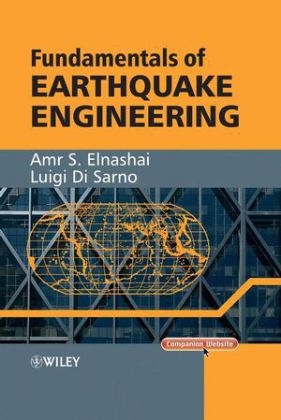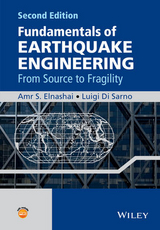
Fundamentals of Earthquake Engineering
John Wiley & Sons Ltd (Verlag)
978-0-470-02483-6 (ISBN)
- Titel erscheint in neuer Auflage
- Artikel merken
Fundamentals of Earthquake Engineering includes material on the nature of earthquake sources and mechanisms, various methods for the characterization of earthquake input motion, damage observed in reconnaissance missions, modeling of structures for the purposes of response simulation, definition of performance limit states, structural and architectural systems for optimal seismic response, and action and deformation quantities suitable for design. The accompanying website at www.wiley.com/go/elnashai contains a comprehensive set of slides illustrating the chapters and appendices. A set of problems with solutions and worked-through examples is available from the Wley Editorial team. The book, slides and problem set constitute a tried and tested system for a single-semester graduate course. The approach taken avoids tying the book to a specific regional seismic design code of practice and ensures its global appeal to graduate students and practicing engineers.
Professor Amr Elnashai is Bill and Elaine Hall Endowed Professor at the Civil and Environmental Engineering Department, University of Illinois at Urbana-Champaign. He is Director of the National Science Foundation (NSF) multi-institution multi-disciplinary Mid-America Earthquake Center. He is also Director of the NSF Network for Earthquake Engineering Simulation (NEES) Facility at Illinois. Amr obtained his MSC and PhD from Imperial College, University of London UK. Before joining the University of Illinois in June 2001, Amr was Professor and Head of Section at Imperial College. He has been Visiting Professor at the University of Surrey since 1997. Other visiting appointments include the University of Tokyo, the University of Southern California and the European School for Advanced Studies in Reduction of Seismic Risk, Italy, where he serves on the Board of Directors since its founding in 2000. Amr is a Fellow of the Royal Academy of Engineering in the United Kingdom (UK-equivalent of the NAE), Fellow of the American Society of Civil Engineers and the UK Institution of Structural Engineers. He is founder and co-editor of the Journal of Earthquake Engineering, editorial board member of several other journals, a member of the drafting panel of the European design code, and past senior College Unwin Prize for the best PhD thesis in Civil and Mechanical Engineering (1984), the Oscar Faber Medal for best paper in the Institution of Structural Engineering, and two best paper medals from the International Association of Tall Buildings, Los Angeles. He is the administrative and technical team builder and director of both the MAE center and NEES@UIUC Simulation Laboratory, at Illinois. Amr is President o the Asia-Pacific Network of Centers of Earthquake Engineering Research (ANCER), a member of the FIB Seismic Design Commission Working Groups and two Applied Technology Council (ATC, USA) technical committees. He founded the Japan-UK Seismic Risk Forum in 1995 and served as its director until 2004. He leads a FEMA project for impact assessment for the eight central US states, was advisor to the UK Department of the Environment, advisor to the Civil Defense Agency of Italy, and review panel member for the Italian Ministry of research and the New Zealand and Canadian Science research Councils. Amr's technical interests are multi-resolution distributed analytical simulations, network analysis large-scale hybrid testing, and field investigations of the response of complex networks an structures to extreme loads, on which he has more than 250 research publications, including over 110 refereed journal papers, many conference, keynote and prestige lectures (including the Nathan Newmark Distinguished Lecture), research reports, books and book chapters, magazine articles, and field investigation reports. Amr has successfully supervised 29 PhD and over 100 Masters Theses. Many of his students holds significant positions in industry, academia and government in over 12 countries. He has a well-funded research group, with a large portfolio of projects from private industry, state agencies, federal agencies, and international government and private entities. Amr taught many different subjects both at Illinois and at Imperial college. He is recognized as an effective teacher and has been on the 'incomplete list o teaches considered excellent by their students' twice at UIUC. He has contributed to major projects for a number of international companies and other agencies such as the World Bank, GlaxoWellcome (currently GSK), Shell International, AstraZeneca, Minorco, British Nuclear Fuels, UK Nuclear Installations Inspectorate, Mott MacDonald, BAA, Alstom Power, the Greek, Indonesian and Turkish Governments, and the National Geographic Society. He is currently the Greek, Indonesian and Turkish Governments, and the National Geographic Society. He is currently working on large projects for the Federal Emergency Management Agency (FEMA), State Emergency Management Agencies, Istanbul Municipality, US AID, Governments of Pakistan and Indonesia, among others. Amr enjoys scuba-diving and holds several certificates from the British Sub-Aqua Club and the US Professional Association of Diving Instructors. He also enjoys reading on history, the history of painting and film-making. Dr Luigi Di Sarno is Assistant Professor in Earthquake Engineering at the University of Sannio (Benevento), and holds the position of Research Associate at the Department of Structural Engineering (DIST), University of Naples, Federico II in Italy. He graduated cum laude in Structural Engineering from the University of Naples, Federico II. He then obtained two MSc degrees in Earthquake Engineering and Structural Steel Design from Imperial College, London. In 2001 Dr. Di Sarno obtained his PhD from University of Salerno in Italy and moved to the University of Illinois at Urbana Champaign in 2002 where he worked as a Post-doctoral Research Associate. He has been Visiting Professor at the Mid-America Earthquake Center at Illinois since 2004. His research interests are seismic analysis and design of steel, reinforced concrete and composite structures, and the response to tall buildings to extreme loads, on which he has written more than 60 research publications, including over 15 refereed journal papers, many conference papers, research reports, book chapters and field investigation reports. Dr. Di Sarno continues to work with the active research group at the University of Naples, with a large portfolio of projects from private industry, state agencies, and international government and private entities. He taught several courses at Naples, Benevento and the Mid-America Earthquake center. He is currently working on large projects funded by the Italian State Emergency Management Agency (DPC) and the Italian Ministry of Education and Research, amongst others. Dr. Di Sarno enjoys reading on history, science and art. He also enjoys playing tennis and swimming.
About the Authors. Foreword. Preface and Acknowledgements. Introduction. List of Abbreviations. List of Symbols. 1. Earthquake Characteristics. 1.1 Causes of Earthquakes. 1.1.1 Plate Tectonics Theory. 1.1.2 Faulting. 1.1.3 Seismic Waves. 1.2 Measuring Earthquakes. 1.2.1 Intensity. 1.2.2 Magnitude. 1.2.3 Intensity-Magnitude Relationships. 1.3 Source-to-Site Effects. 1.3.1 Directional Effects. 1.3.2 Site Effects. 1.3.3 Dispersion and Incoherence. 1.4 Effects of Earthquakes. 1.4.1 Damage to Buildings and Lifelines. 1.4.2 Effects on the Ground. 1.4.3 Human and Financial Losses. References. 2. Response of Structures. 2.1 General. 2.2 Conceptual Framework. 2.2.1 Definitions. 2.2.2 Strength-versus Ductility-Based Response. 2.2.3 Member-versus System-Level Consideration. 2.2.4 Nature of Seismic Effects. 2.2.5 Fundamental Response Quantities. 2.2.6 Social-Economic Limit States. 2.3 Structural Response Characteristics. 2.3.1 Stiffness. 2.3.2 Strength. 2.3.3 Ductility. 2.3.4 Overstrength. 2.3.5 Damping. 2.3.6 Relationship between Strength, Overstrength and Ductility: Force Reduction Factor 'Supply'. References. 3. Earthquake Input Motion. 3.1 General. 3.2 Earthquake Occurrence and Return Period. 3.3 Ground-Motion Models (Attenuation Relationships). 3.3.1 Features of Strong-Motion Data for Attenuation Relationships. 3.3.2 Attenuation Relationship for Europe. 3.3.3 Attenuation Relationship for Japan. 3.3.4 Attenuation Relationships for North America. 3.3.5 Worldwide Attenuation Relationships. 3.4 Earthquake Spectra. 3.4.1 Factors Influencing Response Spectra. 3.4.2 Elastic and Inelastic Spectra. 3.4.3 Simplified Spectra. 3.4.4 Force Reduction Factors (Demand). 3.4.5 Design Spectra. 3.4.6 Vertical Component of Ground Motion. 3.4.7 Vertical Motion Spectra. 3.5 Earthquake Records. 3.5.1 Natural Records. 3.5.2 Artificial Records. 3.5.3 Records Based on Mathematical Formulations. 3.5.4 Scaling of Earthquake Records. 3.6 Duration and Number of Cycles of Earthquake Ground Motions. 3.7 Use of Earthquake Databases. 3.8 Software for Deriving Spectra and Generation of Ground-Motion Records. 3.8.1 Derivation of Earthquake Spectra. 3.8.2 Generation of Ground-Motion Records. References. 4. Response Evaluation. 4.1 General. 4.2 Conceptual Framework. 4.3 Ground Motion and Load Modelling. 4.4 Seismic Load Combinations. 4.5 Structural Modelling. 4.5.1 Materials. 4.5.2 Sections. 4.5.3 Components and Systems for Structural Modelling. 4.5.4 Masses. 4.6 Methods of Analysis. 4.6.1 Dynamic Analysis. 4.6.2 Static Analysis. 4.6.3 Simplified Code Method. 4.7 Performance Levels and Objectives. 4.8 Output for Assessment. 4.8.1 Actions. 4.8.2 Deformations. 4.9 Concluding Remarks. References. Appendix A - Structural Configurations and Systems for Effective Earthquake Resistance. Appendix B - Damage to Structures. Index.
| Erscheint lt. Verlag | 3.10.2008 |
|---|---|
| Zusatzinfo | Illustrations |
| Verlagsort | Chichester |
| Sprache | englisch |
| Maße | 169 x 249 mm |
| Gewicht | 766 g |
| Themenwelt | Technik ► Bauwesen |
| ISBN-10 | 0-470-02483-6 / 0470024836 |
| ISBN-13 | 978-0-470-02483-6 / 9780470024836 |
| Zustand | Neuware |
| Informationen gemäß Produktsicherheitsverordnung (GPSR) | |
| Haben Sie eine Frage zum Produkt? |
aus dem Bereich



